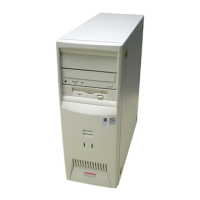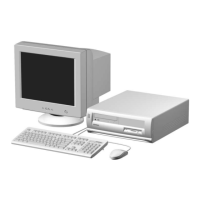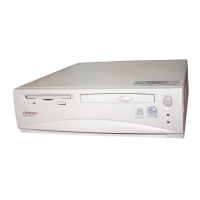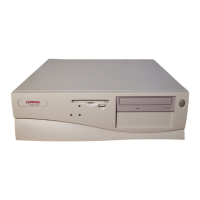Technical Reference Guide
Compaq Deskpro EP Series of Personal Computers
First Edition–- April 1998
4-49
4.7.3 87309 I/O CONTROLLER CONFIGURATION
The 87309 I/O controller contains various functions such as the keyboard/mouse interfaces,
diskette interface, serial interfaces, and parallel interface. While the control of these interfaces
uses standard AT-type I/O addressing, the configuration of these functions uses indexed ports
unique to the 87307. These systems use I/O addresses 015Ch and 015Dh at reset as the
Index/Data ports for accessing the logical devices within the 87309. The 87309 is set in PnP
motherboard mode. The integrated logical devices are listed as follows:
Table 4-18 lists the PnP standard configuration registers for the 87309.
Table 4–22.
87309 I/O Controller PnP Standard Configuration Registers
Table 4-22.
87309 I/O Controller PnP Standard Configuration Registers
Index Function Reset Value
00h Set RD_DATA Port 00h
01h Serial Isolation
02h Configuration Control
03h Wake (CSN) 00h
04h Resource Data
05h Status
06h Card Select Number (CSN) 00h
07h Logical Device Select:
00h = Diskette Controller
01h = Parallel Port
02h = UART 2 (Serial Port B)
03h = UART 1 (Serial Port A)
04h = Power Management
05h = Mouse I/F
06h = Keyboard I/F
06h
20h Super I/O ID Register (SID) A0h
21h SIO Configuration 1 Register 16h
22h SIO Configuration 1 Register 02h
23h Programmable Chip Select Configuration Index 00h
24h Programmable Chip Select Configuration Data 00h
NOTES:
For a detailed description of registers refer to appropriate National documentation.
The configuration registers are accessed using the follow procedure:
1. Write the index value of the desired register to 015Ch.
2. Write/READ the data value to 015Dh.
Each logical device selected through indexed register 07h has a set of PnP control, space
configuration, and interrupt configuration registers associated with it. These PnP control registers
are discussed later in chapter 5.

